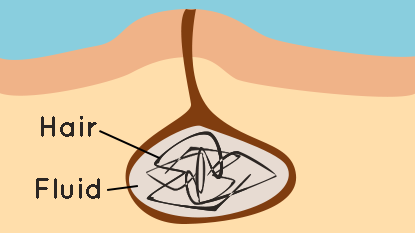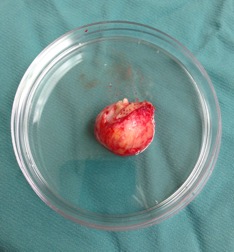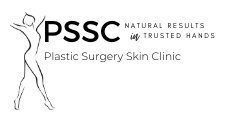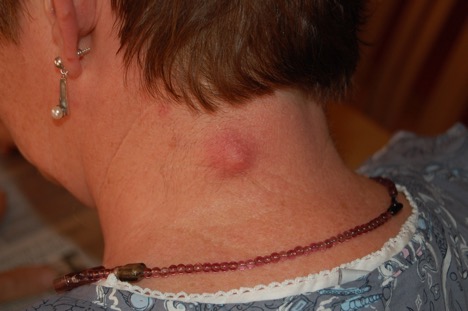Nobody wants to have unsightly lumps or bumps – especially if they’re somewhere everyone can see. In most cases, a cyst is harmless. But if they form on joints (like a ganglion cyst) they can cause discomfort. In rare cases, they can be a symptom of cancer. So any time you have a cyst, it’s important to get it checked out.
Regardless of whether your cyst is benign, odds are you want to get rid of it. To get the most effective cyst removal it’s best to understand what they are, how they form, and what your removal options are.
What is a Cyst?
A cyst is a cosmetic skin lesion that can grow anywhere on the body. Cysts are pockets of membranous tissue full of fluids, dead skin, tissue, or hair. They are typically noncancerous, but it’s always worth getting them examined by a doctor or plastic surgeon.
If you experience pain, get a professional to examine your cyst right away. Usually, pain is indicative of a rupture, infection, or inflammation.
Left untreated, even a benign cyst can cause problems. Although some types of cysts can go away on their own, they may come back. As well, if left alone cysts can grow larger and/or get an infection.
An infected cyst runs the potential risk of blood poisoning if the abscess bursts. Fortunately, cyst removal is generally a simple, outpatient procedure with no complications or side effects.
What Causes Cysts & How Do They Form?
The most common cause for a cyst to form is blocked drainage symptoms, such as clogged sebaceous glands or infections. A blockage can cause fluid, tissue, hair, or dead skin to become trapped under the skin. Your body considers it a foreign object and forms a cyst around it for protection.

For example, a pilonidal cyst can start like an ingrown hair. As the hair goes deeper under your skin, the body covers it in a fluid-filled cyst. On the surface, this can cause a bulge or bump.
Other ways that cysts can form include:
- Genetic conditions
- Cellular defects
- Parasites
- Broken vessel (due to injury)
- Acne cyst
- Keratin buildup
- Piercings
- Tumour (keratocysts & dermoid cysts)
While there are many types and causes of cysts, there are also a number of ways to remove them.
Cyst Removal
The best cyst removal treatment depends on its underlying cause. If you have a cyst, schedule a consultation with a plastic surgeon. There they will discuss your removal options. Typical cyst removal treatments include:
Aspiration
Tiny cysts can sometimes be treated through aspiration. In this case, the plastic surgeon lances the cysts and drains the fluid. They use a drape and sterility kit to help prevent infection.
Surgery
For most cysts, minor surgery is the best option as it completely removes the cyst. This is important because if any of the cyst remains, it can form again.

For most cysts, the surgeon provides local anesthetic to the treatment area. They then use a scalpel and sterile tools to remove the cyst. For a large cyst, they may close the wound with stitches.
The surgeon may aspirate the cyst before operating if it has burst or become infected.
For some types of cysts, surgery requires other equipment. For example, laparoscopic surgery is the typical procedure for ovarian cyst removal. This uses a laparoscope to locate the cyst and surgical instruments then remove it.
Laser Cyst Removal
Laser removal is effective for removing sebaceous cysts, especially for larger lesions or in areas with thick skin. While it takes more sessions than traditional excision, cosmetic lasers don’t leave behind the large scars that can result from removing a large cyst.
Laser cyst removal is only an option if there is no infection present.
Leave It
For smaller sebaceous or ganglion cysts, sometimes the best route is to simply leave it alone. Some cysts are harmless, and may even disappear on their own. Still, it’s best to have a doctor or plastic surgeon examine the cyst to determine both the diagnosis. After all, not all cysts will go away on their own, and they can be symptoms of larger problems.
As well, the doctor can make sure the cyst is not inflamed, burst or infected.
If your doctor recommends leaving it alone, follow these three steps:
- Hands off! No squeezing, scratching or puncturing. Doing so can lead to infection or inflammation. This can result in requiring cyst removal surgery.
- Keep the area clean. Just your regular soap and water cleaning is usually sufficient. Use a gentle technique.
- Apply heat and moisture. Placing a warm, wet towel on the bump for 15-30 minutes increases blood flow and can help speed up healing. You can do this up to 4 times a day, but be careful not to use hot water as it can burn or irritate the skin.
Home Removal
Never try to remove a cyst yourself. This runs a high risk of infection. Trying to lance, drain, or excise the cosmetic skin lesion yourself is more likely to cause the cyst to become worse, or even painful.
Prevention
What causes a cyst determines how to best prevent them in the future. In most cases, there is no surefire prevention. But for some types of cysts, there are preventative measures to reduce the likelihood of reoccurrence.
A pilonidal cyst, for example, can form due to debris getting trapped in pores. Avoiding long sitting periods as well as keeping the area clean and dry can help prevent this cyst.
For those prone to ovarian cysts, hormonal contraceptives can help prevent new ones from forming.
Using a skilled plastic surgeon for cyst removal can help prevent them from reforming. If any part of the sac wall is left behind after removal, there is a risk of the cyst coming back.
Newmarket Cyst Removal Clinic
The Plastic Surgery Skin Clinic is Newmarket’s new destination for cosmetic skin treatments including cyst and skin tag removal. Our plastic surgeons have years of experience in the GTA and are now bringing their services to the NEwmarket area.

